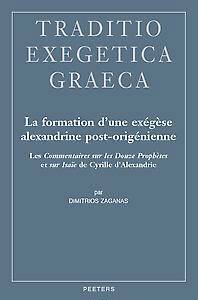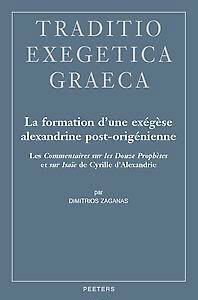
- Afhalen na 1 uur in een winkel met voorraad
- Gratis thuislevering in België vanaf € 30
- Ruim aanbod met 7 miljoen producten
- Afhalen na 1 uur in een winkel met voorraad
- Gratis thuislevering in België vanaf € 30
- Ruim aanbod met 7 miljoen producten
Zoeken
La formation d'une exégèse alexandrine post-origénienne
Les Commentaires sur les Douze Prophètes et sur Isaïe de Cyrille d'Alexandrie
D. Zaganas
€ 115,00
+ 230 punten
Omschrijving
Cyril of Alexandria (c. 378-444) marks a new period in the history of the Alexandrian exegesis. The Christian interpretation of the Bible, previously assigned to teachers, passes now into the hands of the powerful bishop of Alexandria, who clearly overcomes the allegorism of the great masters (Origen, Pierius, Didymus the Blind) whilst borrowing elements from the exegetical model of Eusebius of Caesarea and the Antiochians, maintaining yet the Alexandrian colouring. This evolution is particularly noticeable in the "Commentaries on Isaiah and on the Twelve Prophets", where Theophilus' nephew proposes a more balanced model of interpretation, by emphasizing the importance of the historical-literal dimension of the Scripture. Through a detailed analysis of his exegetical method, this study seeks to highlight the originality of the Cyrilline approach and to underscore Cyril's role in the renewal of the Alexandrian tradition. After going through the most characteristic affinities with Origen, grammarian and allegorist, particular attention is given to the emergence of a post-Origen exegesis in the commentaries of Cyril: changes of terms, method, content and purpose which attest to his commitment to reform. The present study addresses, finally, the thorny question of Cyril's sources, by distinguishing those which show only parallels with him, from those which really influenced him.
Specificaties
Betrokkenen
- Auteur(s):
- Uitgeverij:
Inhoud
- Aantal bladzijden:
- 428
- Taal:
- Frans
- Reeks:
- Reeksnummer:
- nr. 17
Eigenschappen
- Productcode (EAN):
- 9789042938267
- Verschijningsdatum:
- 31/12/2019
- Uitvoering:
- Hardcover
- Formaat:
- Genaaid
- Gewicht:
- 780 g

Alleen bij Standaard Boekhandel
+ 230 punten op je klantenkaart van Standaard Boekhandel
Beoordelingen
We publiceren alleen reviews die voldoen aan de voorwaarden voor reviews. Bekijk onze voorwaarden voor reviews.











